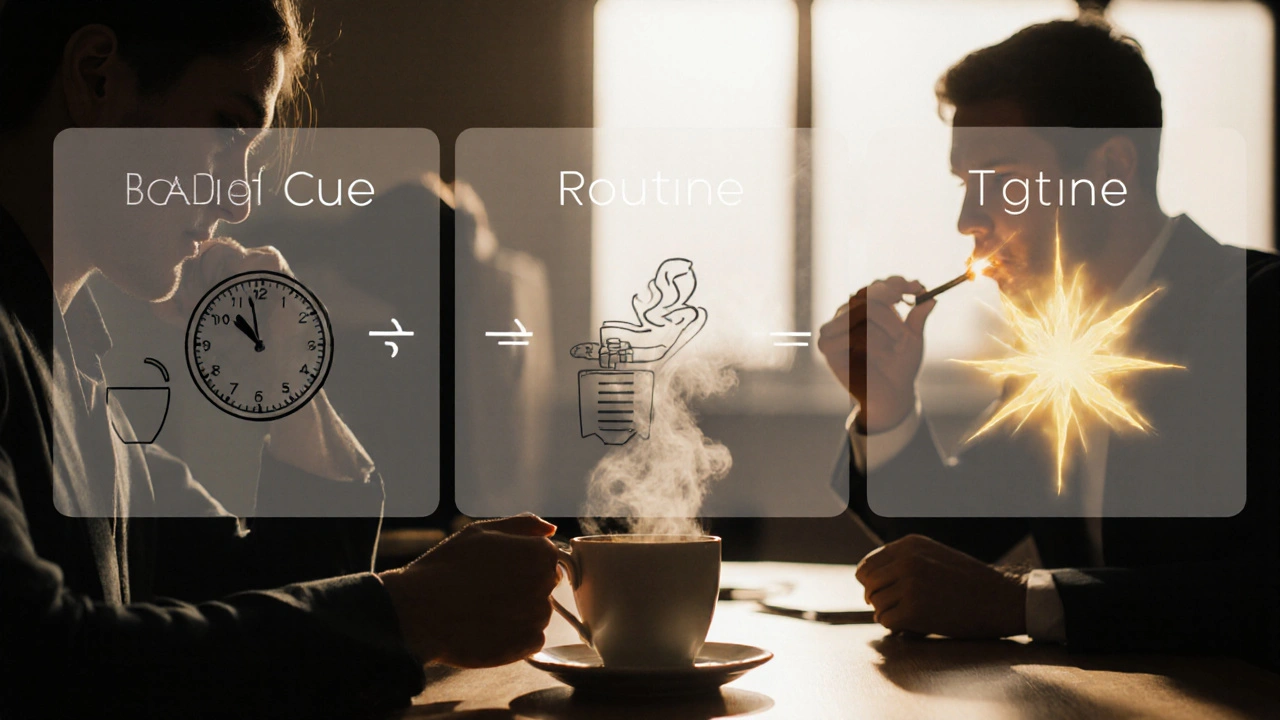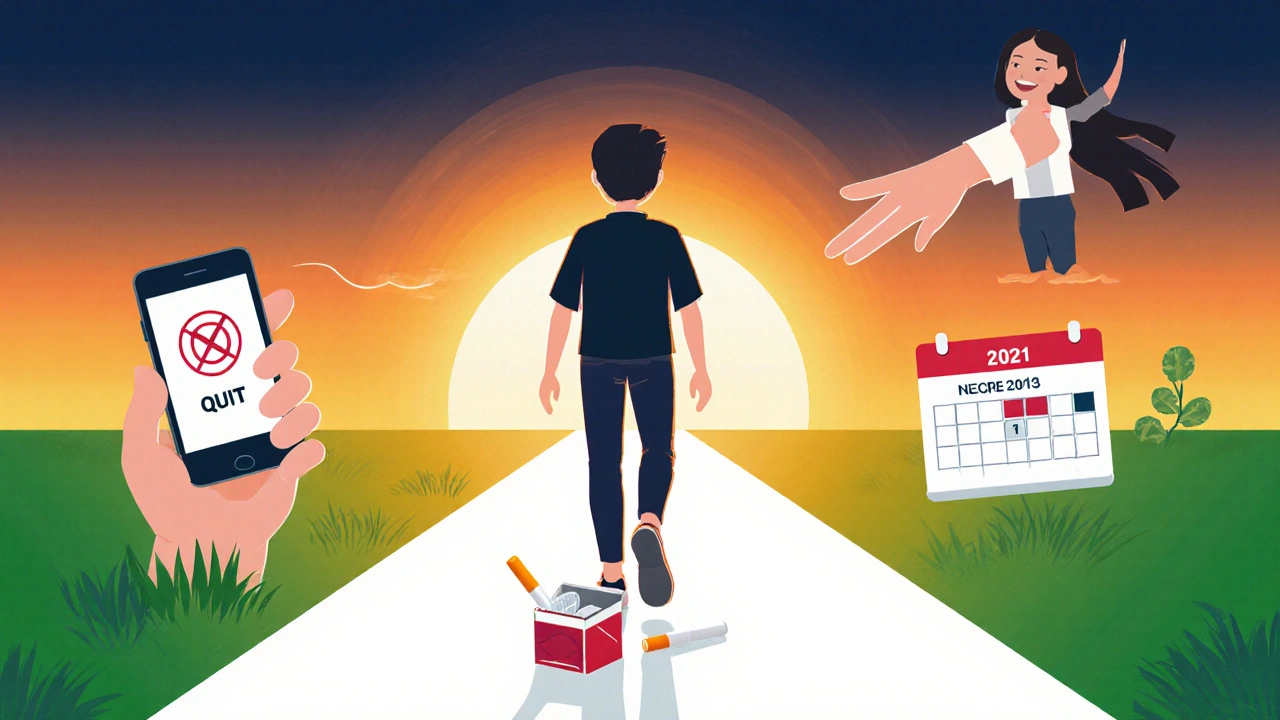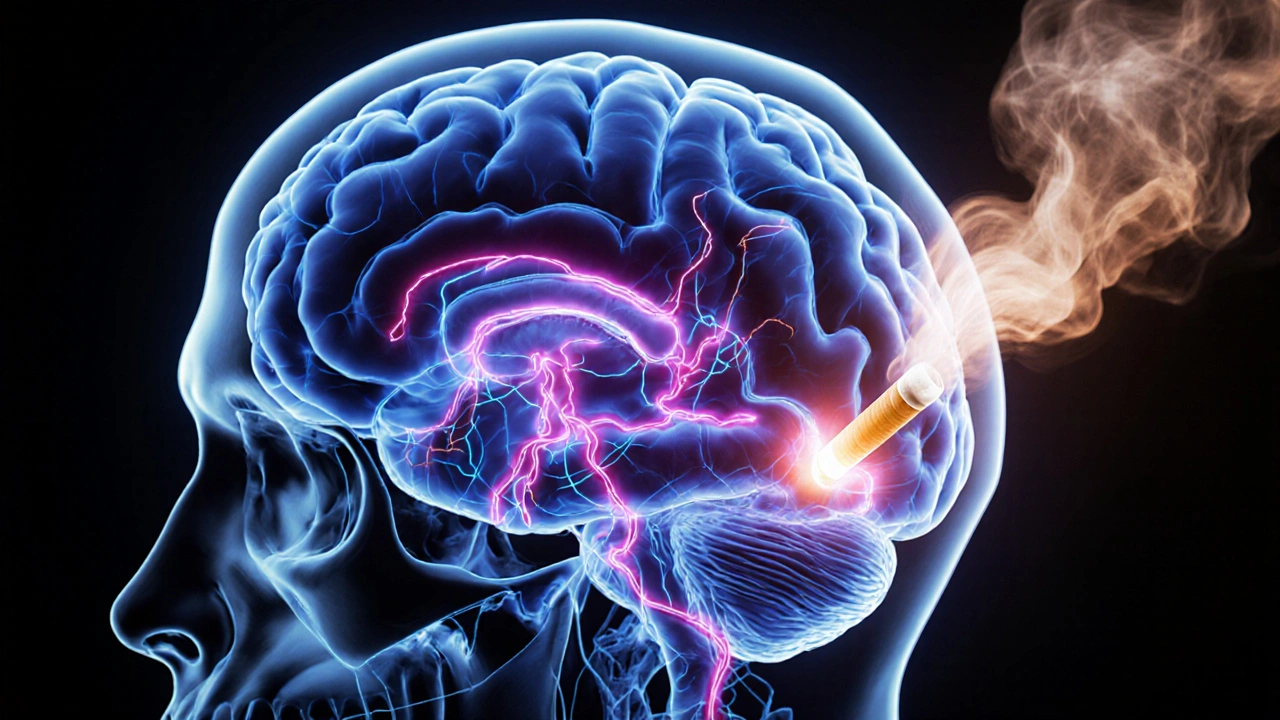Ever tried to quit a cigarette and felt like your brain was sabotaging you? That tug‑of‑war isn’t just willpower-it’s a complex web of psychology, biology, and environment that makes smoking addiction one of the toughest habits to break.
What Exactly Is Smoking Addiction?
Smoking addiction is a chronic dependence on nicotine delivered through tobacco smoke, characterized by compulsive use despite harmful health effects. It belongs to the broader category of substance use disorders and is driven by both chemical and behavioral reinforcement.
The Brain’s Reward Circuit
When you light up, nicotine floods the brain with dopamine a neurotransmitter that signals pleasure and reinforces rewarding behaviors. This spike lights up the reward pathway-mainly the nucleus accumbens-and creates a short, powerful feeling of relief or “buzz.” The brain quickly learns to associate the act of smoking with that reward, forming a habit loop.
From Craving to Habit Loop
Psychologists break down addiction into a three‑step loop: cue, routine, reward. For smokers, a cue could be a coffee break, a stressful meeting, or simply the sight of a lighter. The routine is the act of lighting up, and the reward is the dopamine hit. Over time, the brain automates this loop, turning a conscious choice into an almost reflexive response.
Why Stress Feels Like a Trigger
Stress doesn’t just make you want a cigarette; it actually changes brain chemistry. Cortisol, the stress hormone, interacts with the nicotine receptors, making the craving feel more urgent. This is why many people report smoking more during tough periods-your body is seeking a quick way to dampen the stress response.
Social and Environmental Cues
Smoking isn’t a solo act for most. Social settings, workplace breaks, and even movies can act as powerful cues. The social learning process where individuals mimic behaviors observed in peers makes quitting harder when your friends or colleagues still smoke. The environment constantly reminds you that smoking is “normal” or even “cool.”

Withdrawal: The Body’s Counter‑Attack
When you quit, nicotine levels plummet, and the brain’s chemistry shifts dramatically. Common withdrawal symptoms-irritability, difficulty concentrating, insomnia-are the brain’s attempt to regain equilibrium. These symptoms typically peak within three days and can last several weeks, fueling the relapse cycle.
Psychological Barriers to Quitting
- Identity attachment: Many smokers see cigarettes as part of their self‑image-“I’m a smoker, that’s who I am.”
- Fear of weight gain: Nicotine suppresses appetite, so the prospect of putting on pounds can deter quit attempts.
- Low self‑efficacy: Past failed attempts erode confidence, making the next try feel doomed.
- Optimism bias: Believing “I’ll quit tomorrow” delays action.
Effective Strategies Backed by Psychology
Understanding the mental mechanics opens the door to targeted interventions. Below is a quick‑look comparison of the most common cessation tools, highlighting how each tackles a specific psychological hurdle.
| Method | How It Works | Psychological Target | Typical Success Rate |
|---|---|---|---|
| Nicotine Replacement Therapy (NRT) | Delivers low‑dose nicotine via patches, gum, or lozenges to ease withdrawal. | Reduces physical cravings, allowing focus on habit‑loop reshaping. | ≈ 15‑25% quit at 6months (higher with support). |
| Prescription Medications (e.g., varenicline, bupropion) | Blocks nicotine receptors or modulates neurotransmitters. | Attenuates reward response, weakening the dopamine “buzz.” | ≈ 25‑30% quit at 6months. |
| Cognitive‑Behavioral Therapy (CBT) | Identifies triggers, teaches coping skills, rewires thought patterns. | Targets cue‑routine‑reward loop and stress management. | ≈ 20‑35% when combined with medication. |
| Digital Apps & Text Support | Provides real‑time prompts, tracking, and community encouragement. | Boosts self‑efficacy and offers immediate cue replacement. | ≈ 10‑15% alone; higher with multicomponent plans. |
| Cold‑Turkey (Abrupt Quit) | Stops all nicotine intake at once. | Relies on strong willpower; often fails due to unmanaged cues. | ≈ 5‑10% long‑term abstinence. |
Building a Personal Quit Plan
- Set a quit date: Choose a realistic day within the next two weeks. Mark it on your calendar and share it with supportive friends.
- Identify top three triggers: Write down when and where you most crave a cigarette. Common ones are coffee, after meals, and stressful meetings.
- Choose a replacement strategy: Whether it’s nicotine gum, a breathing exercise, or a short walk, have a ready alternative for each trigger.
- Gather support: Sign up for a quit‑line, download an app, or join a local group. Human connection dramatically improves success odds.
- Prepare for setbacks: Expect occasional slips. Treat them as data, not defeat-analyze what slipped and adjust the plan.

Common Myths That Stall Progress
- "I’ll only smoke a few cigarettes and it won’t matter." Even a single cigarette can reignite the neural pathways, making full relapse far more likely.
- "E‑cigarettes are a safe way to quit." While they reduce some toxins, they still deliver nicotine and perpetuate the habit loop.
- "I can quit anytime I want." Addiction rewires the brain; quitting usually requires structured assistance.
When to Seek Professional Help
If you’ve tried quitting multiple times, or if withdrawal symptoms severely impact daily life, it’s time to talk to a healthcare provider. They can prescribe medications, refer you to counseling, or enroll you in an intensive cessation program. Remember, asking for help is a sign of strength, not weakness.
Maintaining Long‑Term Abstinence
Staying smoke‑free is a marathon, not a sprint. Long‑term strategies include:
- Regularly revisiting your trigger list-new stressors appear over time.
- Celebrating milestones-each smoke‑free month boosts confidence.
- Continuing to engage in healthy habits-exercise, balanced diet, and adequate sleep reduce cravings.
- Keeping a “quit diary” to track moods, cravings, and successes.
Key Takeaways
- Smoking addiction is driven by dopamine‑linked reward loops, stress hormones, and social cues.
- Understanding the cue‑routine‑reward pattern helps you break the habit.
- Combining medication, behavioral therapy, and supportive tools offers the highest success rates.
- Preparation, realistic planning, and addressing myths are essential for lasting change.
Frequently Asked Questions
Can I quit smoking without medication?
Yes, many people quit using only behavioral strategies such as CBT, support groups, and digital apps. However, success rates improve significantly when medication or nicotine replacement is added, especially for heavy smokers.
How long do withdrawal cravings last?
Physical cravings peak within the first three days and typically diminish after two weeks. Psychological cravings, tied to cues and habits, can persist for months, which is why ongoing support is crucial.
Are e‑cigarettes a good quitting tool?
E‑cigarettes can reduce exposure to some harmful chemicals, but they still deliver nicotine and keep the hand‑to‑mouth habit alive. They are generally less effective than proven cessation programs and may lead to dual use.
What role does stress management play in quitting?
Stress amplifies nicotine cravings by increasing cortisol levels. Techniques like mindfulness, deep‑breathing exercises, and regular physical activity can lower stress hormones, making it easier to resist urges.
How can I keep my social circle supportive?
Tell friends and family about your quit date and ask them to avoid smoking around you. Join non‑smoking groups or activities where tobacco isn’t present, and consider a “smoke‑free” challenge with peers to create mutual accountability.


Comments
Allan Jovero
The neurobiological mechanisms underlying nicotine dependence are well‑documented in peer‑reviewed literature. Nicotine acts as an agonist at nicotinic acetylcholine receptors, precipitating a rapid influx of calcium ions. This cascade stimulates dopaminergic neurons in the ventral tegmental area, culminating in a pronounced dopamine surge within the nucleus accumbens. The resultant reinforcement constitutes the primary reward signal that consolidates the habit loop. Repeated exposure induces neuroadaptations, including up‑regulation of receptor density and desensitisation of downstream pathways. Consequently, the basal dopaminergic tone diminishes, compelling the individual to seek exogenous nicotine to restore equilibrium. Stress hormones, particularly cortisol, exacerbate this imbalance by potentiating nicotine‑induced dopaminergic firing. The interplay between the hypothalamic‑pituitary‑adrenal axis and the mesolimbic system explains why stressful contexts are potent relapse triggers. Moreover, conditioned cues-such as the sight of a lighter or the ritual of morning coffee-activate the prefrontal cortex, prompting anticipatory craving. The prefrontal circuitry mediates executive control, yet chronic nicotine exposure attenuates its inhibitory capacity. This neural weakening accounts for the seemingly involuntary nature of the smoking ritual. From a behavioural standpoint, the cue‑routine‑reward triad operates with near‑automaticity after sufficient repetitions. Intervention strategies, therefore, must target both the pharmacological and the behavioural dimensions to be efficacious. Nicotine replacement therapy supplies a sub‑threshold dose, mitigating withdrawal while permitting the re‑training of habit loops. In isolation, however, NRT fails to address the psychosocial determinants, underscoring the necessity of adjunctive cognitive‑behavioural approaches.
On October 12, 2025 AT 03:01
Andy V
Your explanation of the dopamine surge hits the nail on the head, but let me add that many smokers simply ignore the science and keep lighting up because the craving feels immediate and real. The brain’s rewiring isn’t a polite suggestion; it’s a relentless push that overrides rational thought. That’s why quitting feels more like fighting an invisible opponent than making a lifestyle choice.
On October 22, 2025 AT 14:13
Tammie Sinnott
Okay, so picture this: you’re at your favorite coffee shop, the espresso machine hisses, and suddenly you’re itching for a drag like it’s the climax of a thriller. That’s the cue‑routine‑reward loop doing its drama‑queen act, and it’s not just in your head – it’s wired deep in the brain. The stress factor? Imagine cortisol as that annoying background music that makes the nicotine hit feel even more urgent. Social settings crank it up another notch because humans love copying each other, especially when it looks "cool" on screen. Withdrawal? It’s basically your brain screaming, "Hey, where’s my buzz?" for a few days before it calms down. The good news is you can rewrite the script with CBT, apps, or even a simple walk when the urge hits. Trust me, the first week feels like an endless loop, but after that the cravings start to shrink like a glacier melting under the sun.
On November 2, 2025 AT 01:25
Michelle Wigdorovitz
Totally feel you on the coffee‑shop trigger; I’ve swapped the cigarette for a mint gum and it actually gives my mouth something to do while the brain still expects that little hit. The key is to keep the hand busy – doodling, scrolling, or even squeezing a stress ball works wonders when the cue hits.
On November 12, 2025 AT 12:37
Arianne Gatchalian
I’ve seen so many folks get stuck on the “I’m a smoker, that’s my identity” excuse, and it’s heartbreaking. We’re more than the habits we cling to, and reshaping that self‑image can be a game‑changer. Even small victories, like a day without a cigarette, deserve a celebration. Keep building that positive narrative; it chips away at the addiction brick by brick.
On November 22, 2025 AT 23:49
Aly Neumeister
Exactly!!!; the identity stuff is sooo powerful-; you have to replace it with something else, like a hobby or a new routine-. It’s all about re‑wiring those neural pathways!!
On December 3, 2025 AT 11:01